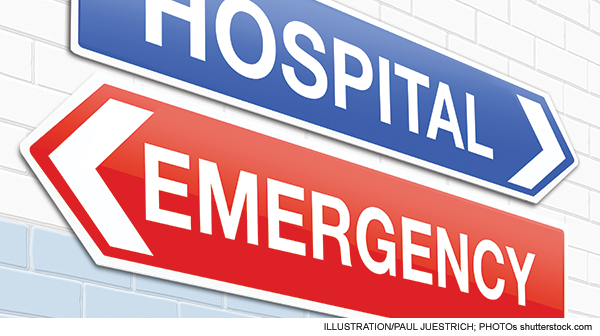
On a recent Friday, Pattie Malone, MD, worked the emergency room at Ocean Beach Hospital, a 25-bed, critical-access facility in Ilwaco, a small city in the extreme southwestern corner of Washington State. She admitted a patient, but once the patient was admitted, that wasn’t the end—their paths would cross again.
Explore This Issue
ACEP Now: Vol 33 – No 05 – May 2014When her regular ED shift was done, Dr. Malone, a doctor with EmCare, put on a second hat: She became Ocean Beach’s hospitalist, too, rounding on inpatients over the remainder of the weekend.
“It actually can enhance patient quality and safety because I am taking care of this person who I saw the day before, and so I build momentum,” Dr. Malone said. “I admitted the patient the day before, I knew the goals of admission, I know the criteria for discharge and what I’m looking for.”
Ranks of Hospitalists Growing
It’s becoming more and more common for emergency physicians to work simultaneously as hospitalists in the nation’s smallest hospitals—generally those with no more than 10,000 to 12,000 ED visits per year. It’s a subset of a trend toward a single company providing a hospital with both emergency physicians and hospitalists.
With so many hospitals already hiring contract management groups to staff their emergency departments and many also hiring companies for their hospitalists, the single-source model is an automatic progression for enterprising contract management groups when hospitals are looking extra hard for ways to streamline their operations and cut costs.
Another major factor is the shortage of hospitalists and the rising cost to a hospital of paying hospitalists, said Mark Hamm, CEO of EmCare Hospital Medicine. EmCare began as an emergency medicine company and branched into hospital medicine about five years ago.
“If you look at supply and demand, there’s not enough hospitalists—there’s about 50,000 hospital medicine opportunities for about 30,000 physicians,” he said. “What that’s doing is driving up the cost of hospital medicine.”
By handling both the hospitalist and emergency medicine services, EmCare said it could help hospitals save money by providing improved efficiencies. EmCare does work at 585 total facilities, providing emergency medicine at 477 of them. Of those, 115 use EmCare for both ED and hospitalist service. And 32 are “Complete Care” clients, who use single doctors as both emergency doctors and hospitalists. In 2012, EmCare had 126 client “starts,” with 34 using both EM and HM. In 2013, there were 187 starts, with 45 using both services.
A Team Approach
EmCare uses specially designed software in its “Door to Discharge” program to integrate emergency and hospital medicine services, meant to improve physician collaboration, increase “throughput” times from the ED to an inpatient bed, and reduce incidents when patients leave the ED without getting treatment. Throughput times using the model average about 45 minutes. “They don’t sit in the ER for three to four hours,” Hamm said. “We’re changing the efficiencies of the hospital.”
At TeamHealth, based in Knoxville, which serves more than 860 facilities and physician groups and began as an emergency-medicine company, about 50 hospitals have signed on for both emergency medicine and hospital medicine services.
“We have seen an increase over the past few years in interest from hospitals who want a combined ED and HM program,” said Tracy Young, TeamHealth’s marketing and communications vice president.
John Proctor, MD, MBA, president of TeamHealth Central Group, said there’s a big advantage in “having those two groups of physicians function as colleagues who are accountable to the same folks and are striving for the same goals.”
TeamHealth uses a proprietary “integrated scorecard” that jointly assesses emergency medicine and hospital medicine. “I think it’s important to look at things not in silos,” said Jasen Gundersen, MD, MBA, president of TeamHealth Hospital Medicine. The scorecard looks at things like observation rate, throughput times, and patient experience.
“The single biggest thing we see from the balanced scorecard from our dashboard now is just a much cleaner and stronger understanding between the two service lines of what happens on the other side and a much larger sense of ownership of the entire continuum,” Dr. Gundersen said. “The ED folks can see what’s happening on the inpatient side, and the inpatient docs can see what’s happening on the ED side.”
It’s becoming more and more common for emergency physicians to work simultaneously as hospitalists in the nation’s smallest hospitals—generally those with no more than 10,000 to 12,000 ED visits per year. It’s a subset of a trend toward a single company providing a hospital with both emergency physicians and hospital medicine physicians.
Quality Improvements
There’s been a “significant improvement” in readmission rates in places where the two sides are under TeamHealth, he said. There’s also been an improvement in throughput times. And as patients wait less in the ED to go to a room, there’s a trend—though not yet statistically validated—toward improvement in Hospital Consumer Assessment of Healthcare Providers and Systems (HCAHP) scores.
The corporate emergency-medicine landscape is seeing more entrants into hospital medicine all the time. Atlanta-based ApolloMD began providing hospitalists to hospitals in the middle of 2013.
“Many of our clients were actually asking that we provide both services,” CEO Mike Dolister, MD, said. “Hospitals are asking for this type of synergy much more than they were even a year ago.”
The key is the throughput time, and having the two sides tied together improves that, Dr. Dolister said: “Because the throughput has such a significant impact on clinical quality in a variety of clinical scenarios, when we improve the throughput, we know it improves the quality and patient experience.”
The Hybrid Model
The ultimate integration, of course, is the emergency physician who also takes care of patients who’ve been admitted, the “hybrid” model. This is almost exclusively done in thinly populated rural areas. The work is usually performed by physicians with a family medicine background or internal medicine background, and who also have emergency medicine experience.
With just a single physician present in a hospital, the possibility of acute situations arising in both an inpatient room and the ED does exist, but choosing the right facility for the model is crucial. “If you properly design the program based on the volume and acuity of the patients in both the EM and the HM programs, these situations should be rare,” he said. “Of course, you can’t always predict volume and acuity. And if you have the ability to flex up and flex down, that would be great, but you can’t always do that.”
At TeamHealth, the decision on whether to use a single doctor as emergency provider and hospitalist is calculated carefully. “We use a very algorithmic approach to how we staff and manage these programs,” Dr. Gundersen said. “We have not had an issue arise, but that’s because we’ve really looked at it mathematically.”
“Agreements with hospitals protect physicians from having to maintain a presence in the inpatient ward, and outlines how an acute situation in the inpatient arena might be handled in that scenario,” Dr. Proctor said.
The hybrid model is an advantage to the emergency physician who makes extra money for seeing the inpatients. “It can be advantageous and attractive to the emergency physicians and it’s something that they volunteer to do when they’re interested,” said Dr. Proctor of TeamHealth.
At Ocean Beach Hospital, Dr. Malone emphasizes that the hybrid model makes sense: the volume is low, with a half-dozen or so inpatients a day, and the ED visits only total about 7,000 a year.
“This is not for high-volume places, this is not for anything other these community critical access hospitals that really don’t have the high volume,” she said. “It’s not overwhelming. It is absolutely doable and that’s why it’s being done.”
Thomas R. Collins is a freelance medical writer based in West Palm Beach, Fla.
Pages: 1 2 3 4 | Multi-Page






No Responses to “Emergency Physicians Increasingly Work Simultaneously as Hospitalists in Nation’s Smallest Hospitals”